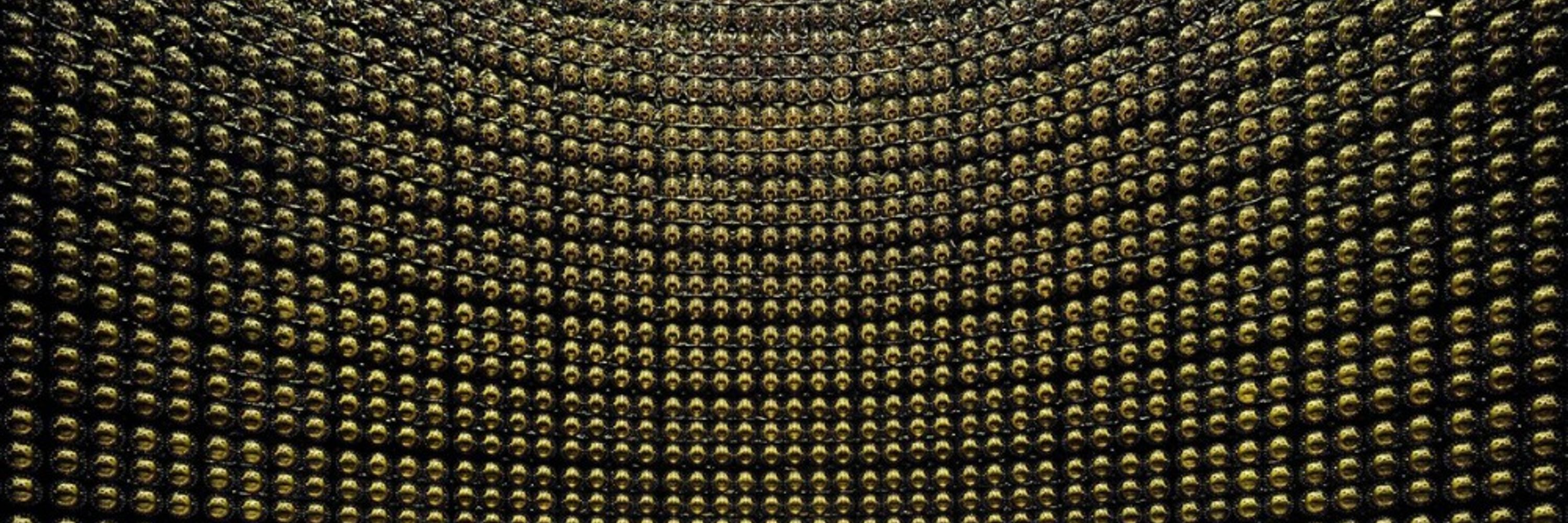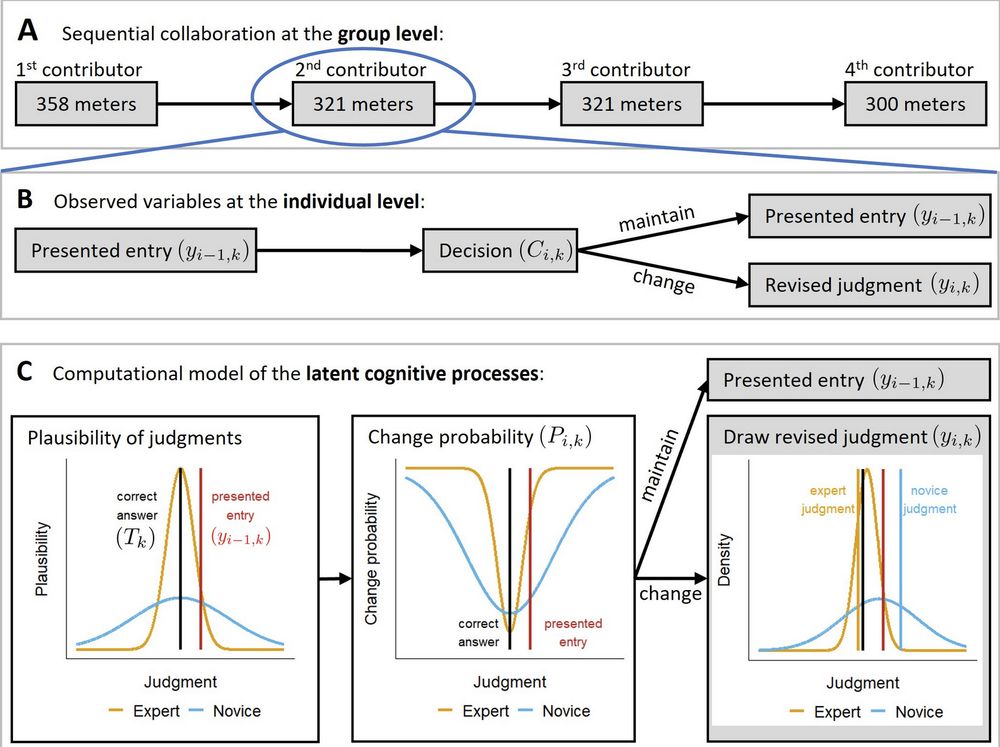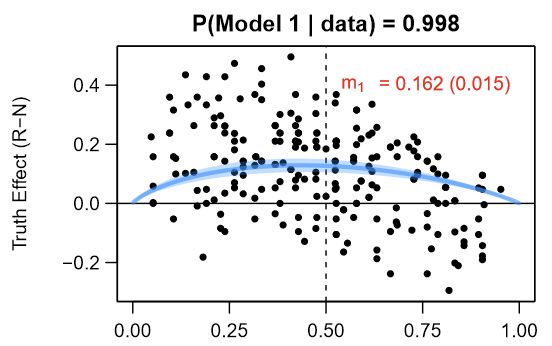
Daniel Heck
@danielheck.bsky.social
Professor of Psychological Methods @Phillips-Universtät Marburg
Mathematical psychology | Cognitive modeling | Psychometrics | Bayesian statistics
Personal: www.dwheck.de
Team: https://www.uni-marburg.de/de/fb04/team-heck
Mathematical psychology | Cognitive modeling | Psychometrics | Bayesian statistics
Personal: www.dwheck.de
Team: https://www.uni-marburg.de/de/fb04/team-heck
The method worked better than simple aggregation for validation words such as "fifty-fifty chance", "never" or "always" (indicated in the plot by the black intervals compared to the gray interval areas).

November 5, 2025 at 3:26 PM
The method worked better than simple aggregation for validation words such as "fifty-fifty chance", "never" or "always" (indicated in the plot by the black intervals compared to the gray interval areas).
Just submitted a minor bugfix of RRreg to CRAN:
github.com/danheck/RRre...
The R package focuses on analyzing univariate & multivariate data collected with the Randomized Response Technique (RRT), which protects anonymity in surveys by randomly scrambling responses.
I also added a new logo 🚀
github.com/danheck/RRre...
The R package focuses on analyzing univariate & multivariate data collected with the Randomized Response Technique (RRT), which protects anonymity in surveys by randomly scrambling responses.
I also added a new logo 🚀

July 22, 2025 at 9:33 AM
Just submitted a minor bugfix of RRreg to CRAN:
github.com/danheck/RRre...
The R package focuses on analyzing univariate & multivariate data collected with the Randomized Response Technique (RRT), which protects anonymity in surveys by randomly scrambling responses.
I also added a new logo 🚀
github.com/danheck/RRre...
The R package focuses on analyzing univariate & multivariate data collected with the Randomized Response Technique (RRT), which protects anonymity in surveys by randomly scrambling responses.
I also added a new logo 🚀
of course, we also need a new badge!

July 8, 2025 at 9:35 AM
of course, we also need a new badge!
New preprint by my PhD student @semihaktepe.bsky.social:
Revisiting the Effect of Discrepant Perceptual Fluency on Truth Judgments
osf.io/preprints/ps...
We could not replicate the effect that higher color contrast results in higher truth judgments in two online experiments (N=98 and N=294).
Revisiting the Effect of Discrepant Perceptual Fluency on Truth Judgments
osf.io/preprints/ps...
We could not replicate the effect that higher color contrast results in higher truth judgments in two online experiments (N=98 and N=294).

February 3, 2025 at 9:32 PM
New preprint by my PhD student @semihaktepe.bsky.social:
Revisiting the Effect of Discrepant Perceptual Fluency on Truth Judgments
osf.io/preprints/ps...
We could not replicate the effect that higher color contrast results in higher truth judgments in two online experiments (N=98 and N=294).
Revisiting the Effect of Discrepant Perceptual Fluency on Truth Judgments
osf.io/preprints/ps...
We could not replicate the effect that higher color contrast results in higher truth judgments in two online experiments (N=98 and N=294).
New pulication in JPSP with Isabel Thielmann, Benjamin Hilbig & @schildchristoph.bsky.social
Cheat, cheat, repeat: On the consistency of dishonest behavior in structurally comparable situations
doi.org/10.31234/osf...
--> incentivized dishonest behavior is consistent across 5 weeks & 3 years
Cheat, cheat, repeat: On the consistency of dishonest behavior in structurally comparable situations
doi.org/10.31234/osf...
--> incentivized dishonest behavior is consistent across 5 weeks & 3 years

October 31, 2024 at 8:55 AM
New pulication in JPSP with Isabel Thielmann, Benjamin Hilbig & @schildchristoph.bsky.social
Cheat, cheat, repeat: On the consistency of dishonest behavior in structurally comparable situations
doi.org/10.31234/osf...
--> incentivized dishonest behavior is consistent across 5 weeks & 3 years
Cheat, cheat, repeat: On the consistency of dishonest behavior in structurally comparable situations
doi.org/10.31234/osf...
--> incentivized dishonest behavior is consistent across 5 weeks & 3 years
New publication 🥳
"Personality traits (un)related to dishonest behavior"
(with Benjamin Hilbig & Isabel Thielmann)
--> HEXACO Honesty-Humility is a robust predictor of incentivized, dishonest behavior which is not the case for Big-5 Agreeableness.
journals.sagepub.com/doi/full/10....
"Personality traits (un)related to dishonest behavior"
(with Benjamin Hilbig & Isabel Thielmann)
--> HEXACO Honesty-Humility is a robust predictor of incentivized, dishonest behavior which is not the case for Big-5 Agreeableness.
journals.sagepub.com/doi/full/10....

October 29, 2024 at 9:13 AM
New publication 🥳
"Personality traits (un)related to dishonest behavior"
(with Benjamin Hilbig & Isabel Thielmann)
--> HEXACO Honesty-Humility is a robust predictor of incentivized, dishonest behavior which is not the case for Big-5 Agreeableness.
journals.sagepub.com/doi/full/10....
"Personality traits (un)related to dishonest behavior"
(with Benjamin Hilbig & Isabel Thielmann)
--> HEXACO Honesty-Humility is a robust predictor of incentivized, dishonest behavior which is not the case for Big-5 Agreeableness.
journals.sagepub.com/doi/full/10....
New preprint with Maren Mayer:
Modeling Dependent Group Judgments: A Computational Model of Sequential Collaboration
osf.io/preprints/ps...
The model is consistent with previous findings and makes a novel prediction about long sequential chains of dependent judgments.
Modeling Dependent Group Judgments: A Computational Model of Sequential Collaboration
osf.io/preprints/ps...
The model is consistent with previous findings and makes a novel prediction about long sequential chains of dependent judgments.

June 25, 2024 at 1:57 PM
New preprint with Maren Mayer:
Modeling Dependent Group Judgments: A Computational Model of Sequential Collaboration
osf.io/preprints/ps...
The model is consistent with previous findings and makes a novel prediction about long sequential chains of dependent judgments.
Modeling Dependent Group Judgments: A Computational Model of Sequential Collaboration
osf.io/preprints/ps...
The model is consistent with previous findings and makes a novel prediction about long sequential chains of dependent judgments.
New preprint by my PhD student Semih Aktepe 🥳
Modeling the Link between the Plausibility of Statements and the Truth Effect
osf.io/preprints/ps...
- formalization of simulation-based model
- nonlinear scale transformations & interactions
- Bayesian modeling in Stan
Modeling the Link between the Plausibility of Statements and the Truth Effect
osf.io/preprints/ps...
- formalization of simulation-based model
- nonlinear scale transformations & interactions
- Bayesian modeling in Stan

June 18, 2024 at 1:52 PM
New preprint by my PhD student Semih Aktepe 🥳
Modeling the Link between the Plausibility of Statements and the Truth Effect
osf.io/preprints/ps...
- formalization of simulation-based model
- nonlinear scale transformations & interactions
- Bayesian modeling in Stan
Modeling the Link between the Plausibility of Statements and the Truth Effect
osf.io/preprints/ps...
- formalization of simulation-based model
- nonlinear scale transformations & interactions
- Bayesian modeling in Stan
New preprint by my PhD student @matzekloft.bsky.social:
Discriminant validity of interval response formats: Investigating the dimensional structure of interval widths
osf.io/preprints/ps...
Discriminant validity of interval response formats: Investigating the dimensional structure of interval widths
osf.io/preprints/ps...

June 12, 2024 at 9:06 PM
New preprint by my PhD student @matzekloft.bsky.social:
Discriminant validity of interval response formats: Investigating the dimensional structure of interval widths
osf.io/preprints/ps...
Discriminant validity of interval response formats: Investigating the dimensional structure of interval widths
osf.io/preprints/ps...
In my lecture on statistical modeling, I illustrated the different types of true/observed/fitted/hypothesized covariance matrices that occur in estimation & testing of SEM/CFA models via hexagons and pentagons.
I like the analogy, but probabably it is not valid in all aspects.
I like the analogy, but probabably it is not valid in all aspects.

February 22, 2024 at 1:27 PM
In my lecture on statistical modeling, I illustrated the different types of true/observed/fitted/hypothesized covariance matrices that occur in estimation & testing of SEM/CFA models via hexagons and pentagons.
I like the analogy, but probabably it is not valid in all aspects.
I like the analogy, but probabably it is not valid in all aspects.
This sounds like General Recognition Theory:
Ashby, F. G., & Perrin, N. A. (1988). Toward a unified theory of similarity and recognition. Psychological Review, 95(1), 124–150. doi.org/10.1037/0033...
Ashby, F. G., & Perrin, N. A. (1988). Toward a unified theory of similarity and recognition. Psychological Review, 95(1), 124–150. doi.org/10.1037/0033...


February 6, 2024 at 9:43 PM
This sounds like General Recognition Theory:
Ashby, F. G., & Perrin, N. A. (1988). Toward a unified theory of similarity and recognition. Psychological Review, 95(1), 124–150. doi.org/10.1037/0033...
Ashby, F. G., & Perrin, N. A. (1988). Toward a unified theory of similarity and recognition. Psychological Review, 95(1), 124–150. doi.org/10.1037/0033...
This reminds me of a paper of mine about the most extreme correlation matrices of individual (per-person) effect sizes that are mathematically possible: psyarxiv.com/ca8z4/
a) All correlations are as large as possible (1-factor model)
b) All correlations are as negative as possible (weird model)
a) All correlations are as large as possible (1-factor model)
b) All correlations are as negative as possible (weird model)

November 24, 2023 at 9:17 AM
This reminds me of a paper of mine about the most extreme correlation matrices of individual (per-person) effect sizes that are mathematically possible: psyarxiv.com/ca8z4/
a) All correlations are as large as possible (1-factor model)
b) All correlations are as negative as possible (weird model)
a) All correlations are as large as possible (1-factor model)
b) All correlations are as negative as possible (weird model)
Great paper: "Impossible Hypotheses & Effect-Size Limits"
journals.sagepub.com/doi/10.1177/...
1) The correlation matrix of all population effect sizes must be positive definite.
2) Hence, there is a lower/upper limit to each effect size that is possible (even if we study only a subset of effects)
journals.sagepub.com/doi/10.1177/...
1) The correlation matrix of all population effect sizes must be positive definite.
2) Hence, there is a lower/upper limit to each effect size that is possible (even if we study only a subset of effects)

November 24, 2023 at 9:16 AM
Great paper: "Impossible Hypotheses & Effect-Size Limits"
journals.sagepub.com/doi/10.1177/...
1) The correlation matrix of all population effect sizes must be positive definite.
2) Hence, there is a lower/upper limit to each effect size that is possible (even if we study only a subset of effects)
journals.sagepub.com/doi/10.1177/...
1) The correlation matrix of all population effect sizes must be positive definite.
2) Hence, there is a lower/upper limit to each effect size that is possible (even if we study only a subset of effects)
The website has changed once again....
A version control system would render changes in arguments more transparent.
A version control system would render changes in arguments more transparent.

October 2, 2023 at 11:24 PM
The website has changed once again....
A version control system would render changes in arguments more transparent.
A version control system would render changes in arguments more transparent.
Silently changing one's arguments on a website called "Innocence" to defend oneself does not make the arguments more convincing or credible...
Source: francesca-v-harvard.org/innocence
Source: francesca-v-harvard.org/innocence


October 2, 2023 at 7:25 AM
Silently changing one's arguments on a website called "Innocence" to defend oneself does not make the arguments more convincing or credible...
Source: francesca-v-harvard.org/innocence
Source: francesca-v-harvard.org/innocence

